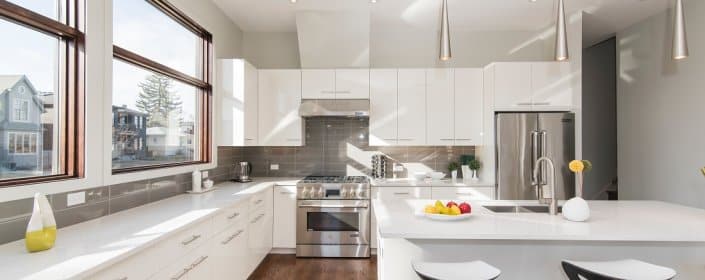Whether You’re Designing a Home with New Windows or Opting for Replacement Windows, Use These Tips to Enjoy Natural Light in Your Home
Some townhomes, condos, and homes may have decreased natural light in some areas, particularly during certain times of day. The good news is that with the right window placement, style, and size, you can maximize your natural light.
Whether you’re shopping for replacement windows, or designing a custom home, consider these tips to maximize natural light during your renovations.
Why Natural Light Is So Advantageous for Your Home
Lighting makes up about 10% of a home’s energy usage. So with more natural light in your home, your lights will be on for less time during the day, and you’ll reduce your energy consumption and electricity bills.
Natural light can also help heat your home in the cooler months. You can make the most of passive solar heat gain in the winter so your home will stay heated naturally by the sun, helping to keep your energy consumption and bills down for heating as well.
Natural Light and Human Nature
Natural light is also beneficial for your health and well-being. The best way to absorb Vitamin D into your body is through sunlight.
Sunlight also helps boost your mood, comfort level, and productivity. Sunlight will increase the levels of endorphins and serotonin in your brain, which help you feel happier and better overall. And increased exposure to sunlight can help fight against insomnia, premenstrual syndrome, and seasonal affective disorder.
Assess Your Surroundings
When deciding where to place your new windows in your home, take a walk around your property and take note of your surroundings, such as the view and direction of sunlight.
You will want to have windows facing beautiful views. But you’ll also want to consider the amount of sunlight that comes in at certain times of the day.
Consider the Purpose/Function of The Room
Based on your preferences, you may want more natural light in some rooms than others. For example, if you want to wake up to the sunlight every morning, then have your bedroom windows facing the east.
Rooms that families use the most, such as the kitchen and laundry room, should have plenty of natural light throughout the day for improved visibility.
Whereas, you may not want as much light the TV room since it will cause a glare on the screen and you’ll end up closing your blinds to block the natural light.
Other rooms, like an office, will benefit from plenty of natural light all day long since you probably don’t want your office becoming dark in the afternoon.
So, keep natural lighting and the purpose of your rooms in mind when deciding on window placement.
Design Your Window for The Perfect View
Window and patio door configurations can make the most of the view outdoors. You can make this view the focal point in the room. And even if the view isn’t great, you can position a window to focus on the best sightline available while blocking undesirable sightlines.
For areas with no view, consider clerestory windows that are high up on the wall. These still let in natural light and fresh air without the eyesore of an unpleasant view.
Use Shapes in Your Design
Using a variety of window shapes in your window designs will add visual interest to your home. A combination of shapes can capture a beautiful panoramic view.
And if you have one excellent view on your property, consider using a wall of windows to frame nature, allowing the outdoors to be part of your interior design.
Make Sure the Design Matches Your Room’s Aesthetic
Consider what each room will look like when deciding on the windows. Large, airy rooms with high ceilings can benefit from windows placed high up the wall. And smaller rooms will look better with windows placed closer to the floor.
Consider Glass Doors in Your Window Design
Glass doors, such as French doors and sliding patio doors, allow plenty of natural light into the home compared to traditional doors.
Glass doors tend to be wider than traditional doors as well with two panes of glass for additional light and an excellent view of the outdoors.
And if you want privacy for some glass doors, especially in your home, consider using frosted or translucent glass.
Skylights
Skylights are the perfect choice for adding natural light to areas that don’t have wall space for traditional windows. Skylights are usually installed on the roof of a home, facing upward toward the sky.
Skylights can be fixed or operable. Operable skylights can open manually with a crank or automatically with a switch or remote control.
Remember: Window Placement Might Affect the Floor Plan
To make the most of the natural light in your home, you don’t want to block any of it with large furniture.
Consider skylights and clerestory windows in rooms with large furniture so you can get the most natural light in without being limited for your floorplan.
Clerestory windows are also ideal for rooms where you want extra privacy, but you don’t want to lose out on natural light, such as in bathrooms.
Read More: DESIGN TIPS TO HELP YOU STYLE AROUND YOUR WINDOWS
Other Design Tips
Paint Eaves White
Consider painting the eaves white and using light shelves to bounce light, reduce glare, and evenly distribute the natural light into your home. Light shelves can be installed on the inside or outside of a window and are usually on the southern-facing side of a house in the sun’s path.
Use Glass throughout Your Home
Glass doors and windows inside your home will help the natural light reach more areas of your home without being obstructed. Reflective glass doors (e.g., on closets) will help bounce light around your home as well.
Chose a Pale Colour Scheme
Pale colours help reflect light, whereas dark, saturated colours absorb light. So if you want more natural light reflected and diffused throughout your home, use a pale colour scheme for your interior paint and décor.
Pick Reflective Flooring
Reflective flooring throughout the home will help bounce light around to maximize the amount of natural light being dispersed. Reflective flooring can have a glossy surface or be light in colour, such as white tile.
How to Decorate North vs. South Facing Windows
North-facing windows provide soft, even light all day while south-facing windows provide bright, direct light.
During the summer, the sun will heat rooms with south-facing windows. So consider using long overhangs to shade the glass. And if not, use curtains on these windows to prevent solar heat gain on hot days.
If you’re happy with the pale light coming into your north-facing windows, then you may not need to cover them at all. Or you can consider using a lighter fabric or shade for a window covering that will still allow some light in while providing privacy when needed.
Natural light can do wonders for your mood, comfort, and home. So consider these tips when shopping for replacement windows and planning new window renovations.


